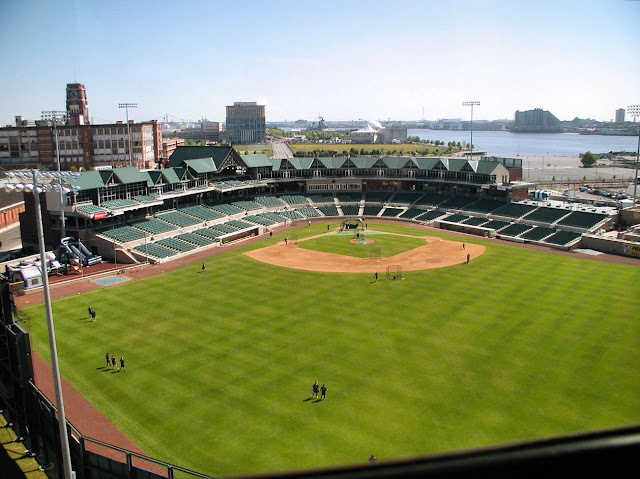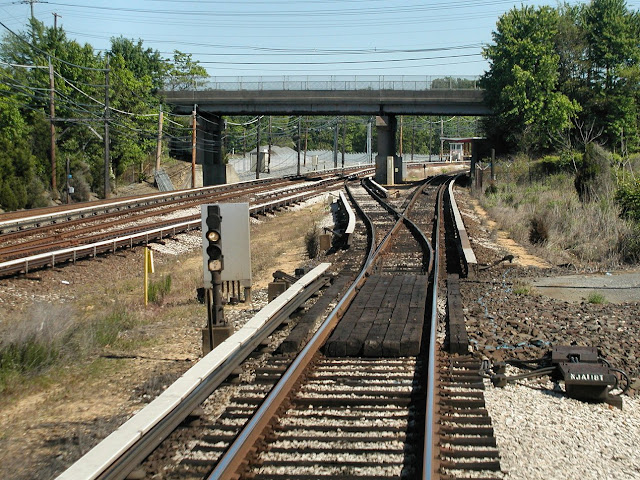In the early 2000's PATCO started a general rebuilding project that would replace a lot of its original 1968 equipment such as ties, poles and rail. Just as this project was starting in 2002, I went out with my new digital camera to take a few photos of the pre-rebuild state of affairs. Also captured are some Broad Street and Atlantic City lines photos. Full galley can be found here.
Starting at the Haddonfield station, NJT GP40PH-2B #4215 trundles through the Atlantic City Line trench in route to Philadelphia. Nearly 20 years later the 2B's would continue to make up the primary source of ACL motive power.
At the other end of the trainset was Commarrow cab car #4166. Originally built as an Arrow I MU car in 1968, the unreliable Westinghouse propulsion equipment had them sidelined after only a few years. Rebuilt as Comet IB cab cars and coaches in the 1980's, they were ultimately displaced on NJT by MultiLevel cars with about half the remaining fleet being rebuil again for service on Amtrak San Joaquin trains in California.
PATCO, and the Broad Street Line it was once connected to, is distinctive in North American transit for retaining use of 3rd rail ramps at interlockings. As seen here at the left of the photo, 3rd rail ramps allow the third rail shoe on diverging movements to ramp on or off the unbroken straight route third rail. Removed on some systems like the NYC Subway due to being a shock hazard to track workers, PATCO has removed some, but not all of their ramps in the intervening years.
The stub end center track at the Ferry Ave station used to be used by occasional short turn peak period trains, however changes in commuting patterns eliminated this service as Ferry Ave turned into just another part of Camden between 1968 and 1980. Later the track was used to store a peak period trainset closer to Philadelphia, as seen here. The platform length of the pocket is only 4 cars long so two cars of the 6 car trainset hang off the end. Seen here is Vickers Canada car #255.
A SEPTA Broad St Line express trainset pulls past the 16L signal and into the tail tracks at WALNUT interlocking as part of a relay move at the Locust-Walnut Station. Until the 2010s it was possible to exit the Walnut-Locust station via stairway at the extreme southern end of the platform for a somewhat more direct connection with PATCO. Unfortunately a station renovation shortened the platform by about 2 carlengths, closed the exit and prevented access to the signal.
PATCO Budd built married pair #246 at 15th/16th station.
PATCO was an early adopter of LED signal lamps, however in 2002, the 2L signal at 16th interlocking still had the original colored glass lenses, including a striking cobalt blue example used to generate lunar white for the proceed indications.
Prior to PATCO, the Bridge Line was an integrated part of the Philadelphia Transit Company's Broad St Line. Trains would terminate and reverse over the bridge at 8th and Market. Today, one of the old connector tracks have been converted into another PATCO storage track that can hold an extra peak period trainset seen here past the 8th St interlocking.
The Camden Riversharks were still a fun new thing in 2002, playing in a brand new stadium on the Camden Waterfront. The Urban Renewal League team would eventually cease operations in 2015 with much of the stadium being demolished for conversion into a venue for Rutgers Camden's D-III baseball team.
Ducking under the road deck of the Ben Franklin Bridge, the eastbound PATCO line enters the Camden portion of its subway, previously used by the Bridge Line rapid transit service until 1968. This location was notable for being the last main line section of track to retain wooden 3rd rail covers.
CP-MILL on the Conrail Vineland Secondary had recently been re-signaled, however the two-track PRR signal bridge would stand for a number of additional years.
Returning past Ferry Ave, the same trainset from a different angle with Vickers car #254 in the lead.
PATCO Vickers car #268 in the Haddonfield trench. Even by the early 2000's PATCO seemed to have a knack for running its 44 1980 vintage Vickers-Canada cars more than its 75 1968 Budd cars.
Prior to the opening of Woodcrest Park and Ride Station in 1980, PATCO would short turn Haddonfield Locals at this pocket track east of town. Today it mostly serves as a glorified crossover.
The 1980 Woodcrest Station's infill status is noticeable from the different shade of ballast and signal numbers higher than those seen at the Lindenwold terminal. Note how the Lunar white of the "main line" signals are not as lunary as those in the subway.
New concrete ties were starting to appear along the right of way at Ashland. The concrete tie and pole line replacement projects would take several years to complete and triggered headway increases due to necessary single tracking. These service cuts would ultimately never be reversed with mid-day headways staying at 20-30 minutes compared with 12-15 minutes prior to the project.
By this point in June of 2002 the concrete ties has been installed on one track at the Lindenwold terminal with the project also including new Union Switch and Signal impedance bonds.
Well that's all I have for pre-rebuild PATCO. One of those things I wish I had gotten some more photos of, but as something I was riding every day in the summers it just didn't seem that exciting :-\



















No comments:
Post a Comment